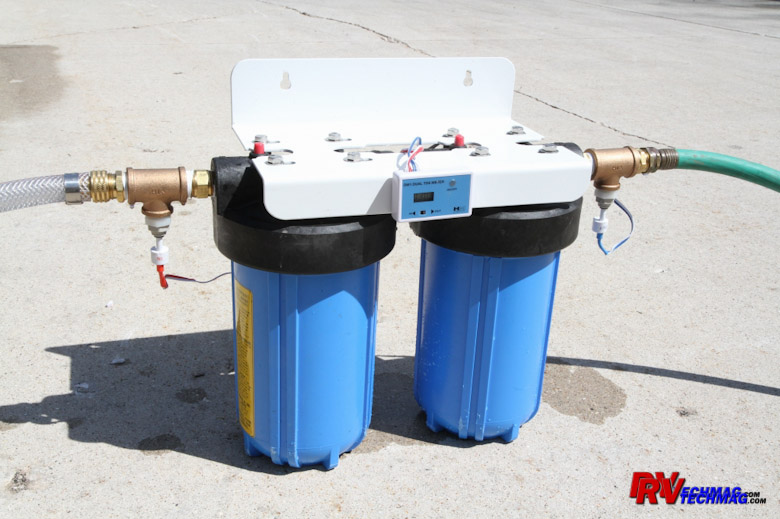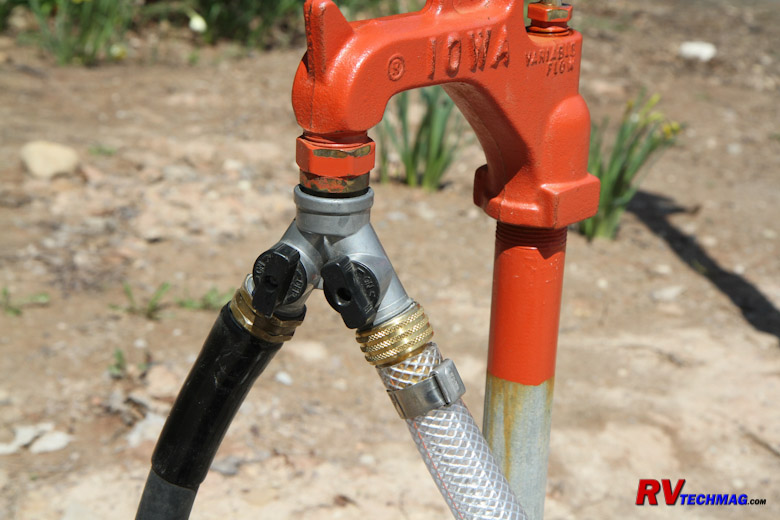CleaRinse Deionization System - Spots Be Gone
Say Goodbye to Hard Water Stains Forever
Article Date: September, 2011
Article and Photography by Mark Quasius

Washing a vehicle can be a time-consuming task. Once the vehicle has been washed, it then becomes a mad scramble
to dry the finish before droplets leave water spots. If the vehicle is a dark color and it's parked in the sun, it requires even greater
speed. A large RV takes this task to a whole new level.
How Spots Are Formed
Water spots occur when minerals in hard water remain after the water has evaporated. Even small amounts of
calcium, iron, magnesium, and other minerals can leave water spots that etch your RV's clearcoat and damage the finish.
Deionization utilizes special ion exchange resins that bind to and filter out the mineral salts from the water.
The resulting water is so pure that there are no minerals in the water to leave any water spots.
We decided to put this system to the test. We received a CleaRinse 78300 Deionization System from G2 Products
in Jupiter, Florida. G2 has been supplying both reverse osmosis (RO) and deionization (DI) systems to the marine industry for nine
years and these units are now being seen in the RV market.
|

The CleaRinse system comes with a dual-line TDS meter to verify both incoming and outgoing total dissolved solids.
|

A Y adaptor that you buy at any hardware store was used to provide regular tap water for washing the RV, while reserving
the CleaRinse system for the final rinse.
|
The 78300 utilizes a dual-canister filter design. Each canister contains a mixed bed DI resin cartridge capable
of filtering 16,900 ppm. The filtration capacity is rated at about 150 gallons of treated water, but the actual number will vary according
to how hard the incoming water is. (Larger systems, as well as bulk resin or replacement filter elements, are available.)
A dual line TDS (Total Dissolved Solids) meter is also installed to indicate how hard your incoming and
outgoing water is as well as when your resin bed cartridge needs to be replaced.
To give it a good test, we tapped into a hydrant that had extremely high amounts of iron and other mineral content.
Our TDS meter showed an incoming water hardness of 266 ppm. The water coming out of the CleaRinse was 32 ppm. The DI system was removing
substantial amounts of mineral-but the true test would be in the actual washing of the coach.
The Results
|
In the past it was impossible to wash the coach without leaving water spots. A 42-foot motorhome has approximately
800 square feet of sidewall surface area. To prevent the soap from drying it was necessary to wash a small area, and then rinse it. This
was done in about 10 to 12 segments, and when we were about a third of the way through the first area was beginning to dry and show
water spots.
With the CleaRinse system we were able to wash the coach in segments, then rinse with the DI water hose and move
on. By the time we finished washing the coach, the first segments were beginning to dry. The results were amazing.
|

Scrubbing a large RV takes time. By the time one area is rinsed, the previous area has dried and left water spots.
|
As the water dried, it left no mineral residue. No towel drying was used, and after all of the water had evaporated
we had nothing left but a shiny, clean coach. Even more impressive was the dark tinted windows. For the first time ever the windows were
spot-free after a wash job.
The time saved by rinsing with the CleaRinse system was significant and made the job much faster and easier-with
better results and less damage to the finish. Anyone with a large full-body painted RV will benefit from and enjoy using this time-saving system.
|

The RV does not need to be towel dried after rinsing with de-ionized water. The water will evaporate by itself and the absence
of mineral content in the water leaves a clear spot-free shine on the RV.
|

Here's a close-up of the RV's graphics. After the RV has been washed with regular faucet water, the RV is rinsed with
water filtered by the CleaRinse system.
|
Source
Clearinse
(561) 596-2085
www.clearinse.com
Return to Home Page
If you enjoyed this article be sure to recommend RVtechMag.com to your friends, like us on Facebook or Twitter
or subscribe to our RSS feed.



|









